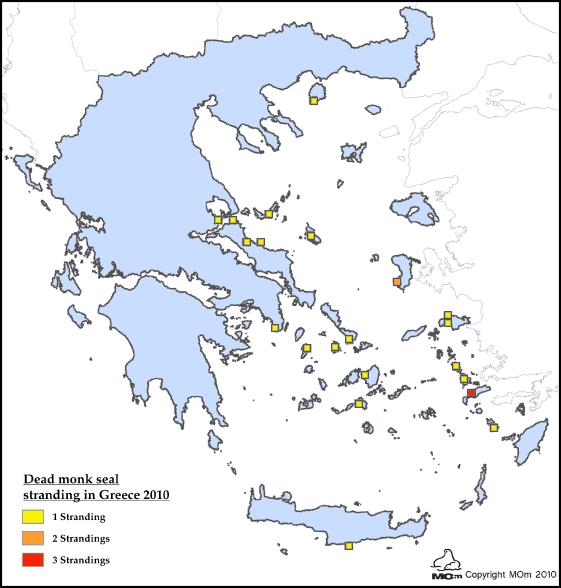

 |
||
 |
||
Vol. 13 (2): December 2010 |
||
Mediterranean monk seal mortality
|
| 1991-2005 | 2005-2009 | |
| Accidental deaths | 16% | 23% |
| Deliberate killings | 39% | 27% |
| Non human induced deaths | 45% | 50% |
Table 1: Causes of death of Mediterranean monk seals in Greece.
In view of the recent spate of deliberate killings of Mediterranean monk seals reported in Greece [Alarming numbers of dead seals, TMG 13(1): June 2010], MOm has carried out a preliminary analysis and assessment and provides to the readers of TMG an updated view for the year 2010. According to current data for this year, MOm received 24 reports of dead monk seal strandings from all over Greece (10 adults, 5 sub-adults, 5 weaners, 1 pup and 3 not identified) (Figure 1). Nine of the dead seals were females, six were males and for nine the gender could not be identified.
22 of these cases were confirmed by local RINT members, while photos were taken of 20 animals, samples were collected from 7, and 4 necropsies were carried out by MOm’s expert staff. In the remaining cases the carcasses were either too decomposed or had already been disposed of, thus no necropsies were performed, nor were samples taken. Conclusive evidence found during the necropsies indicated that two of the deaths were non human induced, one was due to deliberate killing and one was due to accidental entanglement. In 6 other cases and despite the fact that no necropsy was performed, a death cause could be deduced using circumstantial evidence (i.e. photos, observations, samples) provided by local veterinarians and port police authorities. This evidence suggested that 4 animals had been killed deliberately and 2 had died accidentally. In the 12 remaining cases cause of death could not be determined due to the advanced state of decomposition. It should be mentioned that in general, death cause determination is very difficult to establish, and although in some cases there might be indications of deliberate killing, the cause of death is recorded as unknown unless there is compelling specific evidence and findings during the necropsy and the resultant sample analysis.

Figure 1: Map of Greece indicating the distribution of dead monk seal strandings in 2010.
A notable case of deliberate killing this year and unique for its severity and importance was the male pup named Markos. The animal was reported to MOm on 27 April 2010 stranded on a beach in northern Evia [Markos’s Case, TMG 13(1), June 2010]. It had suffered shotgun wounds to the head and had serious respiratory and vision problems. MOm’s Rescue Team performed first aid on site, while further treatment continued at the Veterinary School of Thessaloniki with blood exams, x-rays and administration of antibiotics. The animal was transferred to the MOm rehabilitation centre in Alonnisos, where it stayed for 10 days. It had lost one eye, had serious injuries and a broken jaw that would not permit it to eat or swim. The severity of its injuries proved fatal, and the animal died on 10 May. As a result, and based on the Greek legislation protecting the endangered Mediterranean monk seal, MOm filed a lawsuit, against person or persons unknown for the deliberate killing of young Markos.
Finally, another two deaths from natural causes recorded in 2010 are related to pups that were found orphaned on the islands of Kimolos [‘Iakovos’] and Evia [‘Lazarus’]. Both pups were rescued and admitted for treatment and rehabilitation at the MOm Centre on Alonnisos. Unfortunately, the two pups were extremely malnourished, and died during rehabilitation, raising the total number of confirmed deaths to 24. Detailed analysis of the biological samples of the two pups is still pending, yet preliminary results of the necropsies, carried out by Dr. Geerlag Vanamerongen of the Erasmus University of Rotterdam, indicate that the animals died of starvation.
Based on the above, and on data collected during the whole past operation of the Network, deliberate killings and accidental entanglements in fishing gear affect mostly the adult and sub-adult age classes of the monk seal population in Greece. A temporal analysis of the dataset indicates that mortality rates are highest during winter and spring (i.e. in months February, April and May). Based on RINT reports MOm has estimated that on average 14.8 deaths have been reported annually from 2005 to 2009. The number of dead monk seal strandings recorded in 2010 is the highest since the establishment of the Network. However, these results should be treated with caution because the RINT methodology in terms of effort is not constant and the efficiency of the system increases year by year, as the public and its members become more aware and concerned for the protection of the marine environment and the Mediterranean monk seal.
Despite the lack of proof for an increase of deliberate killing as a major death cause for monk seal populations in Greece, it is a sad fact that such terrible acts are still practiced here. In order to address this situation MOm implemented “MOFI”, an EU funded LIFE Nature project, with the specific aim of mitigating negative monk seal – fisheries interactions and putting an end to the deliberate killing of monk seals. Within the framework of “MOFI”, MOm in collaboration with WWF-Greece and the Fisheries Research Institute and the support of numerous artisanal fisheries associations, formulated a concrete, specific and feasible Action Plan, providing legislative and technical proposals and measures for the mitigation of these interactions. MOm has forwarded the Action Plan to all relevant Ministries and competent authorities, and is pressing for its formal adoption and implementation.
MOm. 2010. Σοβαρά τραυματισμένη μεσογειακή φώκια στο Μαντούδι Ευβοίας/ Mediterranean monk seal found seriously injured in Madoudi. Press release, Thursday, 29 April 2010.
MOm. 2009. Action Plan for the mitigation of the negative effects of monk seal – fisheries interactions in Greece, Summary Report. MOm, WWF Greece, Fisheries Research Institute, 2009: 1-11. [PDF  2.9MB]
2.9MB]